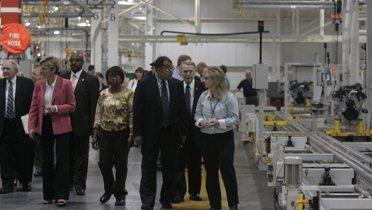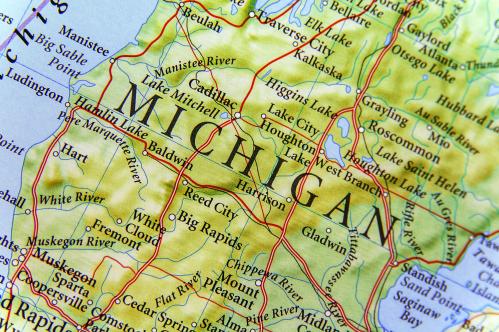The portion of the blogosphere inclined to noodle over Brookings State of Metro America report, included some who now ask, “whither the Rust Belt?” and “whither the Brookings Great Lakes Economic Initiative?”.
I’m pleased to say all are alive and in forward-looking form. The Great Lakes Economic Initiative developed several years ago, not out of a DC-based “mega-region” overlay, but as I traded notes from my years as an elected official and public policy-shaper in Michigan and teamed up with similarly situated political, business and civic leaders from Cleveland, Pittsburgh, Milwaukee, and elsewhere around the region. We basically said, “Don’t we have a similar economic and cultural story? Aren’t we trying to treat the same problems; and leverage the same assets? Isn’t there more we can do working together to accelerate our economic transition?”
At the same time Dick Longworth, a Pulitzer prize-winning former journalist, documented the shared Midwestern and cultural reality in his book Caught in the Middle: America‘s Heartland in the Age of Globalism.
The basic story line of the Great Lakes states was of a region uniquely rich in raw materials and fertile land that became the breadbasket of the growing country, then the world’s manufacturing innovation and creation center.
As the grains of the plains came to Minneapolis-St. Paul, it became the flour-milling and export capital of the world, home to Pillsbury and General Mills. As pigs were slaughtered in Cincinnati, making soap as a byproduct, the consumer products giant Proctor and Gamble grew. As buggy makers in Flint and Detroit were converted by Henry Ford and Billy Durant into Ford and GM, so too metal-benders for farm equipment in Grand Rapids starting making chairs for Steelcase and Herman Miller, electronics innovators in Dayton led to EDS and AC-Delco, iron ore from Duluth-fed US Steel in Gary, Cleveland and Buffalo.
Given its natural bounty (and enabling policies like land giveaways, canal and railroad construction) the region grew rapidly in the 1800s and became densely- populated. Then, most of us made our living on farms, or work linked to farms in small towns. This same region then converted its bounty to finished agricultural and manufactured goods, and it arguably created and ruled the factory-era when 60% of us worked in blue-collar industry.
This region led America in the first two waves of economic organization: the farm, and subsequently the factory economy. It is today making a spotty but accelerating transition to leadership in the 3rd wave, Peter Drucker’s knowledge economy. This new economy was enabled by the internet (largely created by the Big 10 universities) with its concomitant urbanization and metropolitan agglomeration of people, ideas, innovation and jobs. People once moved off the farms to factories; now they are moving to metro-centered offices, labs, studios, universities, hospitals, and related work locations.
So what do metros of this region have in common, if their stories now diverge? Minneapolis-St. Paul is not the flour-milling capital of the world anymore; Chicago is not the meat-packing capital; nor is Pittsburgh the Steel City. All are more diverse (in all good ways)—than they once were. Rochester, New York was once almost as much a company town beholden to Eastman Kodak, (and experiencing similar magnitude of job losses) as Flint, Michigan with GM. They are in different places now.
Beyond the still-significant regional integration of their economies and supply chains and importance of lessons learned from true peers with similar “bones”, the unique economic histories and cultural experiences during the 19th and most of the 20th centuries leave many common socio-economic residues for good and for ill across most of the region.
The good: leading private/public centers of innovation, technological skill, global networks, education institutions, and natural infrastructure. The ill: low education attainment levels, lagging entrepreneurship, aging infrastructure, industrial pollution residues, a dated benefits system , fractured and multiple government units, and a culture of protecting the past, versus embracing the future.
- So metros of the region have a huge stake in figuring out how to capitalize on their water assets as a source of “clean-tech” innovation and jobs, and lakefronts as economic draws—versus water as an input to making paper and steel, or to ship bulk commodities.
- The world’s leading axis of research universities can be fulcrums for solving the nation’s and world’s problems in energy, sustainability, health care and medicine, new materials and can accelerate the transition to knowledge economy leadership
- The nation-leading network of community colleges can be leveraged to retool the skills of today’s manufacturing workforce, for tomorrow’s green- and health-related jobs
- The engineers, IT specialists, and designers laid off by Delphi in Kokomo and Dayton can be the spark for the next round of “gazelle” firms in the country, with appropriate support, training, and early stage capital.
This is the work to do across the region – to accelerate the transition of our unique competencies to leadership in a new era, and the next economy. As my colleague Alan Berube noted — the question for us all, and Brookings in particular, is “what can public policy do to help?”
The Brookings Institution is committed to quality, independence, and impact.
We are supported by a diverse array of funders. In line with our values and policies, each Brookings publication represents the sole views of its author(s).






Commentary
Great Lakes are Dead, Long Live the Great Lakes
June 1, 2010